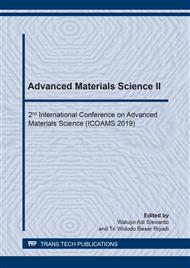[1]
F. Fu and Q. Wang, Removal of heavy metal ions from wastewaters: A review,, J. Environ. Manage., vol. 92, no. 3, p.407–418, (2011).
Google Scholar
[2]
M. A. Barakat, New trends in removing heavy metals from industrial wastewater,, Arab. J. Chem., vol. 4, no. 4, p.361–377, (2011).
Google Scholar
[3]
S. Babel and T. A. Kurniawan, Cr(VI) removal from synthetic wastewater using coconut shell charcoal and commercial activated carbon modified with oxidizing agents and/or chitosan,, Chemosphere, vol. 54, no. 7, p.951–967, (2004).
DOI: 10.1016/j.chemosphere.2003.10.001
Google Scholar
[4]
L. Sörme and R. Lagerkvist, Sources of heavy metals in urban wastewater in Stockholm,, Sci. Total Environ., vol. 298, no. 1–3, p.131–145, (2002).
DOI: 10.1016/s0048-9697(02)00197-3
Google Scholar
[5]
E. Álvarez-Ayuso, A. García-Sánchez, and X. Querol, Purification of metal electroplating waste waters using zeolites,, Water Res., vol. 37, no. 20, p.4855–4862, (2003).
DOI: 10.1016/j.watres.2003.08.009
Google Scholar
[6]
S. Y. Kang, J. U. Lee, S. H. Moon, and K. W. Kim, Competitive adsorption characteristics of Co2+, Ni2+, and Cr3+ by IRN-77 cation exchange resin in synthesized wastewater,, Chemosphere, vol. 56, no. 2, p.141–147, (2004).
DOI: 10.1016/j.chemosphere.2004.02.004
Google Scholar
[7]
S. R. Taffarel and J. Rubio, On the removal of Mn 2+ ions by adsorption onto natural and activated Chilean zeolites,, Miner. Eng., vol. 22, no. 4, p.336–343, (2009).
DOI: 10.1016/j.mineng.2008.09.007
Google Scholar
[8]
Ambarwati, S., Adsorpsi Pewarna Naftol dengan Zeolit sebagai Adsorben,, Skripsi, Jurdik Kimia, FMIPA, UNY, (2005).
Google Scholar
[9]
I. C. Ostroski, M. A. S. D. Barros, E. A. Silva, J. H. Dantas, P. A. Arroyo, and O. C. M. Lima, A comparative study for the ion exchange of Fe(III) and Zn(II) on zeolite NaY,, J. Hazard. Mater., vol. 161, no. 2–3, p.1404–1412, (2009).
DOI: 10.1016/j.jhazmat.2008.04.111
Google Scholar
[10]
T. Motsi, N. A. Rowson, and M. J. H. Simmons, Adsorption of heavy metals from acid mine drainage by natural zeolite,, Int. J. Miner. Process., vol. 92, no. 1–2, p.42–48, (2009).
DOI: 10.1016/j.minpro.2009.02.005
Google Scholar
[11]
Las, T.,dkk., Pemanfaatan Mineral Zeolit Untuk Pengolahan Limbah,, Laporan Akhir Riset Unggulan Terpadu (RUT) Tahun 1995-1997, Jakarta, (1997).
Google Scholar


